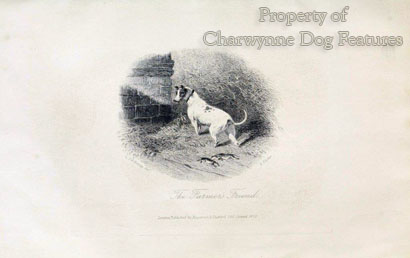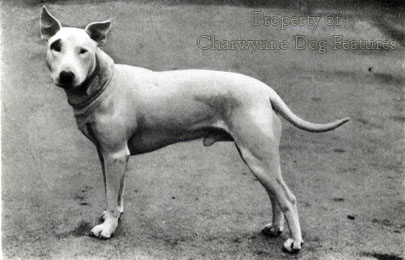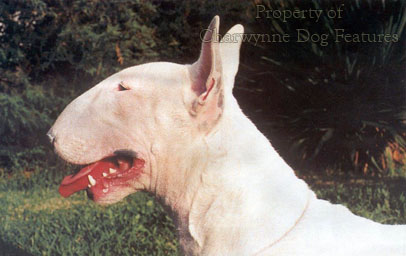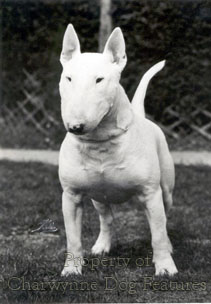178 REBUILDING THE BULL TERRIER
REBUILDING THE BULLTERRIER
by David Hancock
 We once had a breed of dog, created here in Britain but eventually known throughout the British Empire, admired for its bravery, respected for the staunchness of its character, revered for its indomitable spirit and popular, not just because of these qualities, but because it was also robust, unexaggerated, sensibly constructed and stable in temperament. Once its dog-fighting ancestry had been bred out, this breed, the Bull Terrier, became rather more than the 'Bill Sykes' character of the dog world, with its blood being utilised to inject gameness into other breeds from the heelers of Australia to the hunting mastiffs of Argentina.
We once had a breed of dog, created here in Britain but eventually known throughout the British Empire, admired for its bravery, respected for the staunchness of its character, revered for its indomitable spirit and popular, not just because of these qualities, but because it was also robust, unexaggerated, sensibly constructed and stable in temperament. Once its dog-fighting ancestry had been bred out, this breed, the Bull Terrier, became rather more than the 'Bill Sykes' character of the dog world, with its blood being utilised to inject gameness into other breeds from the heelers of Australia to the hunting mastiffs of Argentina.
Referred to early on in its history as the bull and terrier, from its ingredients of terrier and Bulldog, this no-nonsense breed seemed the perfect companion for growing boys and the feared adversary of house-thieves. Writing in the 1890s, the dog writer "Idstone" reported that: "In the country house he is almost indispensible, as he is the resolute and determined enemy of vermin, and an efficient, vigilant guard to stables and outbuildings. His admirable form, combining in an exact proportion the frame best suited for activity, endurance, pace..." 
An outcross to the Dalmatian in his evolution gave the Bull Terrier an affinity with horses and the instinct to follow carriages. The infusion of the English white terrier's blood softened the dogfighting instincts but the courage and stoicism remained. James Hinks of Birmingham is generally regarded as the creator of the all-white Bull Terrier at the end of the 19th century, with his sons continuing his work. It had however been the practice of working terrier enthusiasts to outcross their dogs to the Bulldog every fifth generation or so to instil gameness. Some early Bull Terrier breeders are also alleged to have used Whippet and Pointer blood to achieve the desired conformation. No breeder wanted his dogs to be called bulldoggy or whippety and so the shape of the skull assumed importance. 
The description of the Bull Terrier in 1896 produced by its breed club, established nine years earlier, used these words to describe the head: "...should be long, flat, and wide between the ears, tapering to the nose, without cheek-muscles. There should be a slight indentation down the face, without a 'stop' between the eyes." Winning dogs at the early shows featured heads roughly answering this description. A definite type emerged, based on a determined eye, a strong jaw and overall symmetry.
Sketched by Arthur Wardle in the 1890s, the breed had a confident, athletic, self-assertive look about it, with the head of what might be termed a strong terrier. In his "The Illustrated Book of the Dog" of 1880, Vero Shaw described the head of the Bull Terrier as: "...flat, wide between the ears, and wedge-shaped; that is, tapering from the sides of the head to the nose; no stop or indentation between the eyes is permissable, and the cheekbones should not be visible." Prophetically, Vero Shaw complained about judges, stating that "...we see, show after show, dogs gaining prizes in these classes which do not show one atom of Terrier character in their composition"...going on to describe them as "cow-faced wretches". 
The breed prospered, despite the harm inflicted on so many breeds by the Great War. Then, from the late 1920s, the wording of the breed standard regarding the head changed quite dramatically. The Bull Terrier's head was then expected to appear "oval, almost egg shape" with a profile "...almost an arc from the occiput to the tip of the nose. The more down-faced the better". For the first time in the long history of the dog, a breed was required to have an egg-shaped head. The reason for such a unique and unprecedented feature has never been stated. The Bull Terrier already had a clear identity and an established type when this rewording was agreed, so it could not have been to create a prototype.
Perhaps cynically, one can detect the hand of either one wealthy dominant breeder, or a group of leading fanciers at that time, without the skill to prevent a certain shape of skull developing in their stock. Their predecessors would have probably used outside blood to correct such a tendency but in the modern world of the pedigree dog, such sacrilege cannot be permitted, the gene pool is closed. This is in spite of the skilled, informed outcrossing practised by such master breeders as Millais, with the Basset Hound, Brough, with the bloodhound, Graham, with the Irish Wolfhound and those who re-created the Cavalier King Charles Spaniel. Such breeders never imagined for a moment that their dogs had been stabilised in a physical mould for all time. If alive, they would have bred for renewed type with whatever blood provided this.
Writing on the Bull Terrier before the Second World War, Hogarth described the foreface with this analogy: "...the curve of the profile should be 'Roman', as in, say, the Border, Leicester and Cheviot breeds of sheep." So we now had a redoubtable British breed of dog, renowned all over the world for its guts and gameness, needing to have its head resembling that of a sheep. Why a breed created from a blend of Bulldog and terrier should suddenly need a foreface like a sheep has never been explained. But if you took a pedigree Bull Terrier into a contemporary show ring without an egg-shaped head, you'd be laughed out of the ring. Yet when I see Lyndon Ingles’s magnificent white Bull Terrier ‘Hinks’ at non-KC shows, I have no doubt who is breeding the real Bull Terrier. It can still be done!
The breed standard of the Bull Terrier, as authorised by the Kennel Club today, now includes under "characteristics" these words: "...A unique feature is a downfaced, eggshaped head." This so-called unique feature has only been a feature for seventy years or so; for fifty years before that it was not a feature at all. Such an absurd shape did not characterise the prototypal dogs; James Hinks, his sons and other early breeders: S.E. Shirley, E.H.Adcock, R.J.Hartley and J.H.Ryder would be greatly ashamed to see their dogs betrayed in this way.
Tom Horner, who knew as much about Bull Terriers as anyone in the 20th century, has written on this subject: "The filled-up downfaced head is individual to Bull Terriers...No one knows exactly how it came into the breed, Hink's original white did not have it..." In other words, it never was an original feature of the breed. It is an old tactic to invent new words in order to blur issues or try to justify the unjustifiable. The word "downface" has no meaning; it was coined to legitimise an uncharacteristic undesirable feature which developed in this breed. Horner also wrote: "On balance it seems likely that the filled-up downface is the product of skilled breeding..." I am not sure that it wasn't the product of unskilled breeding by those without the touch of James Hinks and afraid to outcross to remove a strong alien feature cropping up in their stock. Far easier (and defeatist!) to authorise it! Then along comes the Kennel Club and legalises it!
The simple fact is that this "downface" should never have been allowed to develop in this quite admirable breed; it disfigures a famous dog, it attracts ridicule from the general public, it detracts from the symmetry and athleticism desired in such a breed and its mere existence exposes a breach of the original standard laid down by those who first developed this distinguished breed. The fact is that it is an exaggeration, that all exaggerations end up exaggerating themselves and that, in time, the head of the breed will look quite monstrous.
The dog-owning public is coming to its own conclusion. In 1972, there were twice as many Staffordshire Bull Terriers registered as there were Bull Terriers; in 1988 there were three times as many; in 1998 there were four times as many. Twenty or so years ago, I wrote to one of the dog papers expressing my concern not just over the egg-shaped head, but also over the piggy-eyes and stiff movement prevalent in the breed. In response I got a very patronising letter back from the most influential Bull Terrier breeder of the day, which in essence said "Mind your own business, leave such judgements to us."
The well-being and conservation of our precious native breeds of dog, part of our national heritage, is far too important a matter to be left in the hands of breed-point faddists. Every breeder of pedigree dogs should keep in his mind the words of the great foxhound breeder 'Ikey' Bell, in his "The Foxhound's Prayer":
"Remember that your stewardship
Spells trustee to our race.
The duty now before you
Is not to 'mess us up',
And not go running riot
To gain some silver cup."
I go to 'alternative' dog shows, unlicensed by the KC, and see what are termed 'Irish Staffies' and they look exactly like the old prints of our renowned Bull Terrier. They are usually owned by gruff characters, who don't set much store on conforming -- just as Bull Terrier owners didn't in the 19th century! Our Bull Terrier is a very special British breed and it is being ruined by a bunch of misguided show breeders, who have no regard for the breed's classic physique and truly typical head. How can any rational person, especially an alleged lover of that breed, justify the imposition of a sheep's head on a dog's body? It isn't traditional; it isn't an improvement, if anything it is a deformation, a disfigurement. It is an outrageous liberty taken by faddists and condoned by the KC. Any admirer of our native breeds of dog, especially one as characterful as this one, should frown when they see this travesty, this parody being paraded as the real thing. Come on, terriermen of Britain, put this right!